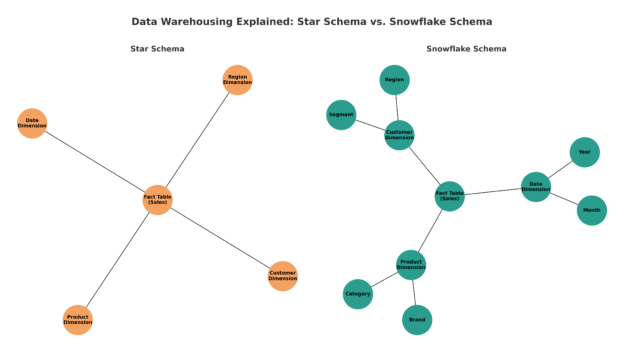When you’re building a data warehouse, the way you model your data can make the difference between fast, intuitive analytics and a never-ending maze of joins. Two of the most common data modeling approaches are Star Schema and Snowflake Schema. Both serve the same purpose—structuring your data to support reporting and analysis—but they differ in design, performance, and usability.
In this article, we’ll break down how each works, where they shine, and how to choose the right one for your business intelligence needs.
What Is a Star Schema?
Think of a star schema as the simplest map to your data warehouse. At the center sits the fact table, which stores measurable events like sales transactions, orders, or website visits. Radiating out from the fact table are dimension tables, which describe the “who, what, when, where, and how” of those facts.
For example:
- Fact table: Sales (order ID, date key, customer key, product key, sales amount)
- Dimension tables:
- Customer (customer ID, name, region)
- Product (product ID, category, brand)
- Date (date ID, day, month, year)
Visually, this structure looks like a star — one central fact table connected directly to multiple dimension tables.
Advantages of Star Schema
- Performance: Fewer joins make queries run faster.
- Simplicity: Easy for analysts to understand and navigate.
- Compatibility: Widely supported by BI tools like Power BI and Tableau.
When to Use
If your warehouse is designed primarily for speed and ease of reporting, a star schema is often the best choice. It’s ideal for dashboards and straightforward business queries.
What Is a Snowflake Schema?
A snowflake schema takes the star schema and normalizes it further. Instead of having one flat dimension table, dimensions can branch out into multiple related tables.
For example, instead of storing product category and brand in the product table, you might split them into separate tables:
- Product table (product ID, product name, category ID, brand ID)
- Category table (category ID, category name)
- Brand table (brand ID, brand name)
This structure looks more like a snowflake—hence the name.
Advantages of Snowflake Schema
- Storage efficiency: Reduces data duplication.
- Data consistency: Categories and hierarchies are managed in one place.
- Flexibility: Supports complex analytical needs like hierarchical roll-ups (e.g., subcategory → category → department).
When to Use
If your warehouse needs to handle complex dimensions or strict normalization rules, snowflake schemas can be a better fit. They’re especially useful in large-scale enterprise data environments.
Star Schema vs. Snowflake Schema: Key Differences
| Feature | Star Schema | Snowflake Schema |
|---|---|---|
| Design | Simple, flat dimensions | Normalized, multi-level dimensions |
| Query Performance | Faster (fewer joins) | Slower (more joins) |
| Ease of Use | Intuitive for business analysts | More complex, requires deeper SQL skills |
| Storage | Uses more space (duplicate data) | More efficient (less redundancy) |
| Best For | Dashboards, self-service analytics | Large, complex, enterprise data warehouses |
How to Choose the Right Schema
Choosing between star and snowflake depends on your goals:
- Prioritize speed and simplicity? → Go with Star Schema.
- Need normalized data and hierarchical detail? → Go with Snowflake Schema.
- Hybrid approach? Some organizations blend the two, using star schemas for performance-critical reporting while snowflaking certain dimensions (like geography or product categories) where normalization matters most.
Final Thoughts
At the end of the day, both schemas are proven strategies in data warehousing. Star schemas make life easier for analysts and BI tools, while snowflake schemas reduce redundancy and support complex hierarchies.
The key is aligning your data model with your analytics strategy. If your business needs quick insights and accessible dashboards, keep it simple with a star. If you’re running a large-scale, detail-oriented warehouse, a snowflake schema might be worth the extra complexity.
Discover more from Daily BI Talks
Subscribe to get the latest posts sent to your email.

